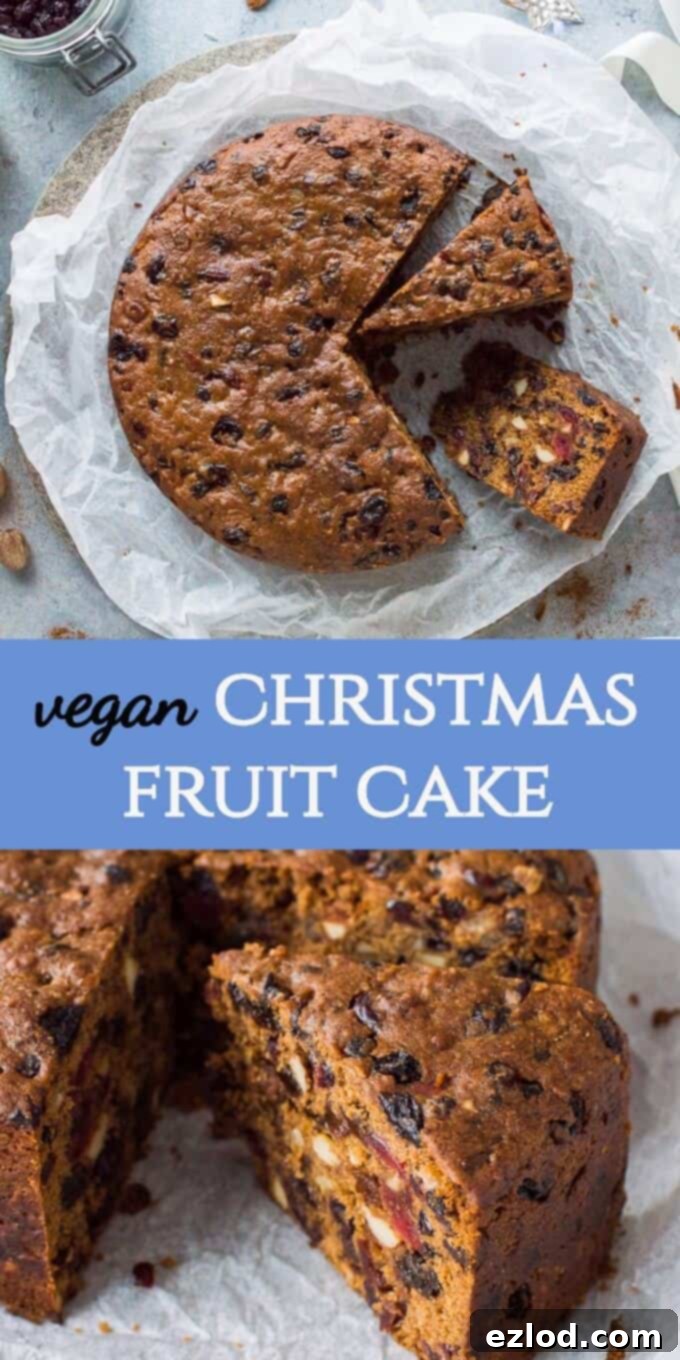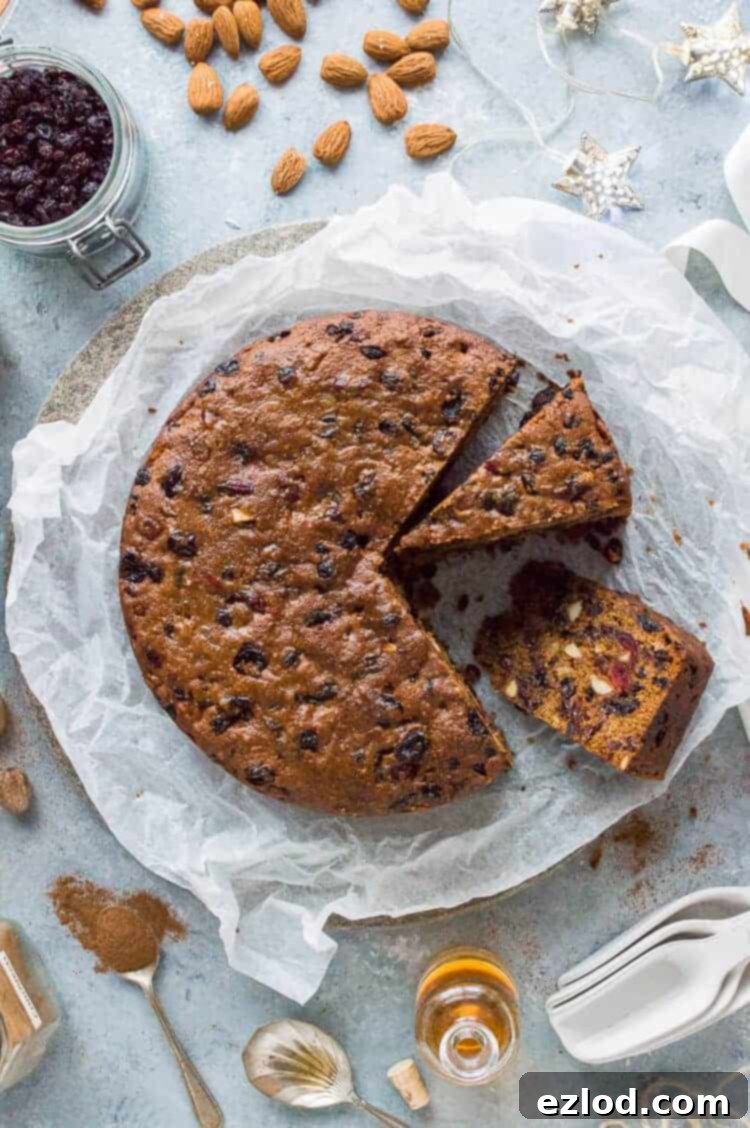The Ultimate Vegan Christmas Cake Recipe: Rich, Moist & Boozy Fruitcake
Experience the magic of Christmas with this incredibly rich, moist, and boozy vegan fruit cake. Perfect for gifting, sharing, or simply indulging throughout the festive season, this recipe delivers a classic taste without any animal products. Whether you bake it for immediate enjoyment or prepare it in advance and “feed” it regularly with rum or brandy, this vegan Christmas cake is destined to become a cherished holiday tradition for all.
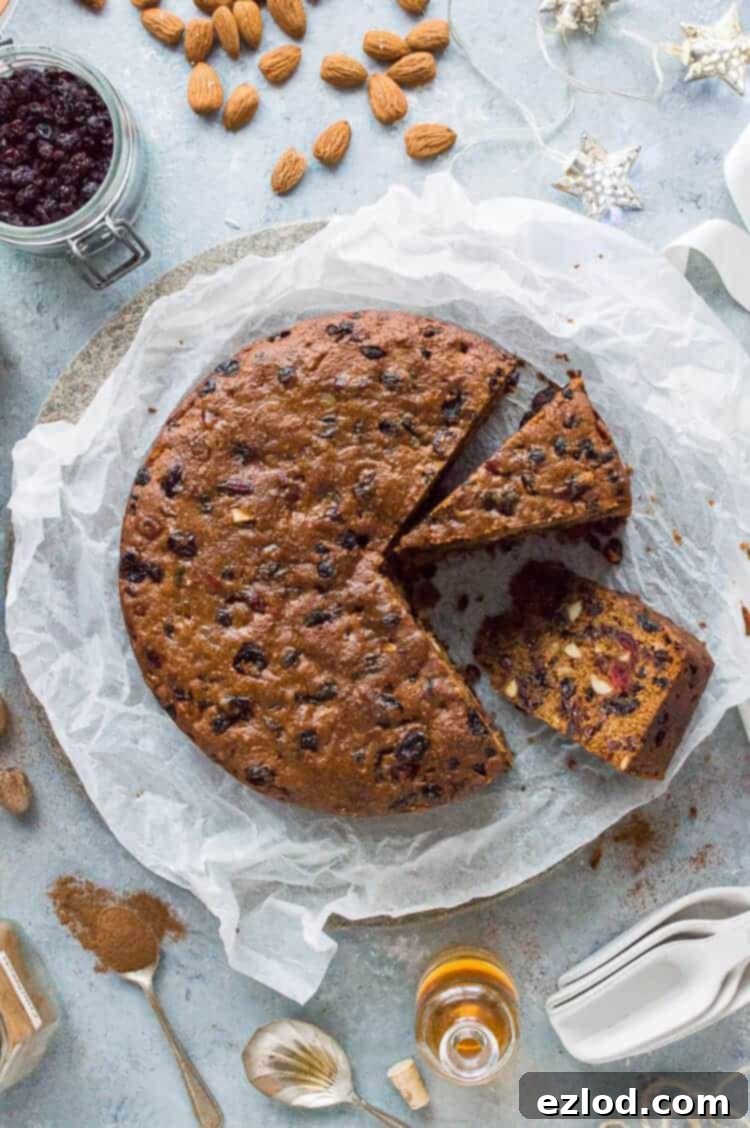
For many, fruitcake is a holiday staple, a comforting blend of aromatic spices and intensely flavoured dried fruits that evokes nostalgic memories of Christmases past. Yet, it’s also a confection that often divides opinions. I confess, I fall squarely into the “love it” camp! Christmas, for me, wouldn’t quite feel complete without a generous slice of a beautifully boozy, deeply flavourful fruitcake to savour during the festive period. While I’ve shared several delightful fruitcake recipes in the past, a truly exceptional vegan version has always been a personal quest – until now. My mission was clear: create a vegan Christmas cake that not only rivals its traditional counterpart but perhaps even surpasses it in richness, depth of flavour, and delightful texture, making it accessible for everyone to enjoy.
This wasn’t a task I took lightly. My kitchen became a dedicated fruitcake testing ground, enduring no less than seven different iterations before I finally perfected this recipe. The result? A vegan fruitcake that, in my humble opinion, is nothing short of perfection. It’s wonderfully moist, exquisitely dense, brimming with plump, boozy fruits, and bursting with aromatic spices. Every bite transports you to the heart of the holiday season, making it an ideal centerpiece for your festive table or a thoughtful homemade gift.
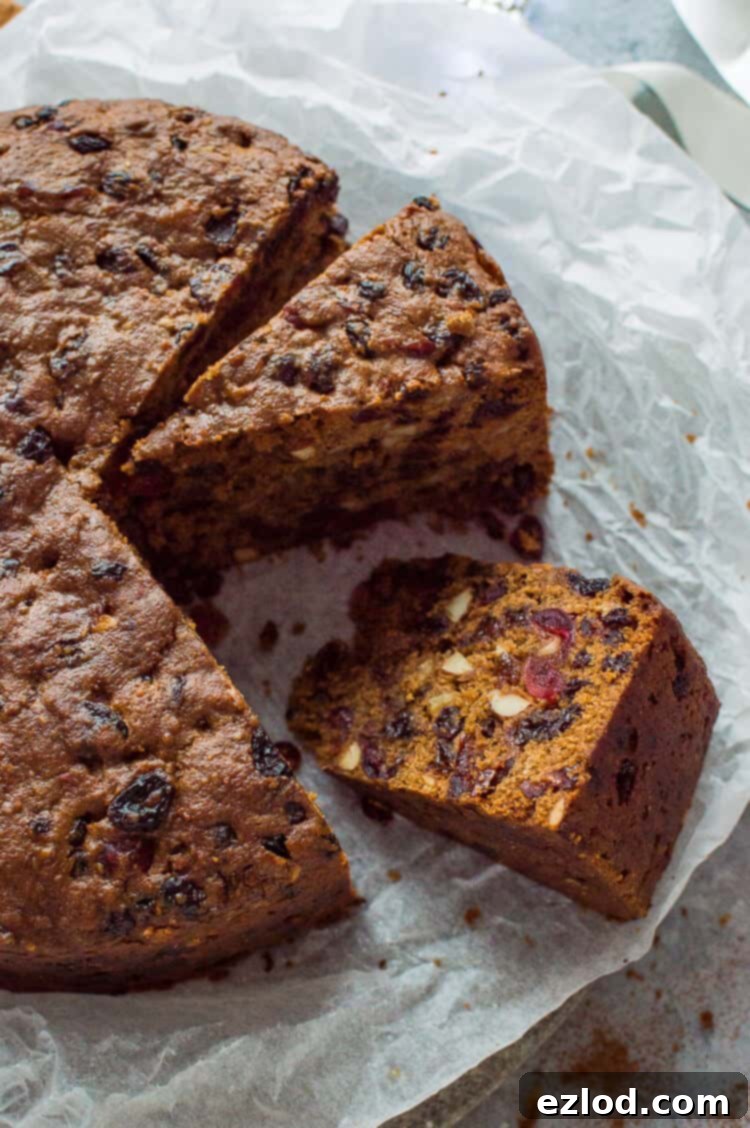
The Secret to an Irresistibly Moist & Boozy Vegan Christmas Cake
The foundation of any great fruitcake lies in its fruit, and for this vegan Christmas cake, we elevate it to an art form. The dried fruits – a delightful and generous mix of raisins, sultanas, currants, cranberries, mixed candied peel, and halved glace cherries – undergo a luxurious pre-soak in your spirit of choice, typically rum or brandy. This crucial step isn’t just about infusing deep, complex flavour; it’s about rehydrating the fruits, making them incredibly plump, tender, and intensely succulent, ensuring they don’t dry out during the long baking time. This process requires a little patience, as the fruit needs to soak for at least overnight, but ideally for up to a week. I personally found three days to be the sweet spot, allowing the fruit to absorb maximum flavour and moisture, resulting in a truly decadent and unforgettable cake. This deep infusion is key to achieving that characteristic Christmas cake richness.
Crafting the Perfect Vegan Cake Batter for a Festive Fruitcake
Once your boozy fruit is perfectly plumped and ready, it’s time to incorporate it into a rich, aromatic batter that forms the heart of this festive creation. This batter is carefully crafted with dark brown sugar and treacle, which collectively lend a deep, caramel-like sweetness and contribute significantly to the cake’s wonderfully moist and dense texture. A vibrant blend of classic aromatic spices – including warming mixed spice (or pumpkin spice), comforting cinnamon, and fragrant nutmeg – along with finely grated orange and lemon zest, infuses the entire cake with that unmistakable, uplifting festive aroma. Furthermore, ground almonds are added, providing a delightful richness and further enhancing the cake’s dense, luxurious, and satisfying texture, making each bite a true indulgence.
During the extensive recipe development phase, I rigorously tested various plant-based fats to achieve the ideal taste and texture for this vegan Christmas cake. Through numerous trials, I discovered that high-quality dairy-free margarine consistently produced superior results compared to coconut oil or sunflower oil. Cakes made with dairy-free margarine were noticeably more flavourful and boasted a perfectly moist, tender crumb that is characteristic of a premium fruitcake. While softened coconut oil can certainly be used as an alternative, it’s important to be aware that it may result in a slightly more crumbly texture and a milder, less pronounced flavour. If you do opt for coconut oil, I highly recommend adding a good pinch of salt to help balance and enhance the overall taste, bringing out more of the spice and fruit notes.
Achieving the perfect lift and structure in a vegan cake without eggs requires clever and reliable substitutes. For this particular recipe, I’ve found that the simple yet effective combination of red wine vinegar and bicarbonate of soda works absolute wonders. This dynamic duo creates a gentle leavening action that helps the cake rise and contributes to its robust structure without compromising on moisture or creating an undesirable crumb. I also experimented with flax eggs during my tests, but found they tended to produce a slightly too crumbly texture, which is far from ideal for a rich, dense, and moist fruitcake. The vinegar and bicarb method ensures a stable, beautifully moist crumb that holds together perfectly, making slicing and serving a breeze.
Bake Ahead for Best Flavour: The Art of “Feeding” Your Vegan Christmas Cake
One of the many cherished qualities of a traditional Christmas cake is its remarkable ability to be made well in advance, allowing its complex flavours to deepen, meld, and mature over time. This rich vegan Christmas cake is no exception; in fact, it truly benefits from this time-honoured practice. While it’s utterly delicious straight from the oven, its true, magnificent potential is unleashed when made up to six weeks ahead of when you plan to serve it. To store your cake effectively, ensure it’s thoroughly wrapped first in baking parchment, then securely in tin foil, and finally placed within an airtight container. Keep it in a cool, dark place, away from direct sunlight or heat.
The magic truly happens during this storage period, as you periodically “feed” the cake. Every week or two, drizzle a couple of tablespoons of your chosen spirit – rum or brandy – over the cake. For even saturation, make sure to alternate applying the spirit to both the top and bottom surfaces of the cake. This traditional process not only keeps the cake incredibly moist and prevents it from drying out, but also continuously infuses it with an even deeper, more complex boozy flavour that develops beautifully over time. Just remember a crucial tip: cease feeding the cake about a week before you plan to ice it. This allows the surface to dry out slightly, creating the ideal texture for better adhesion of your chosen marzipan, royal icing, or fondant.
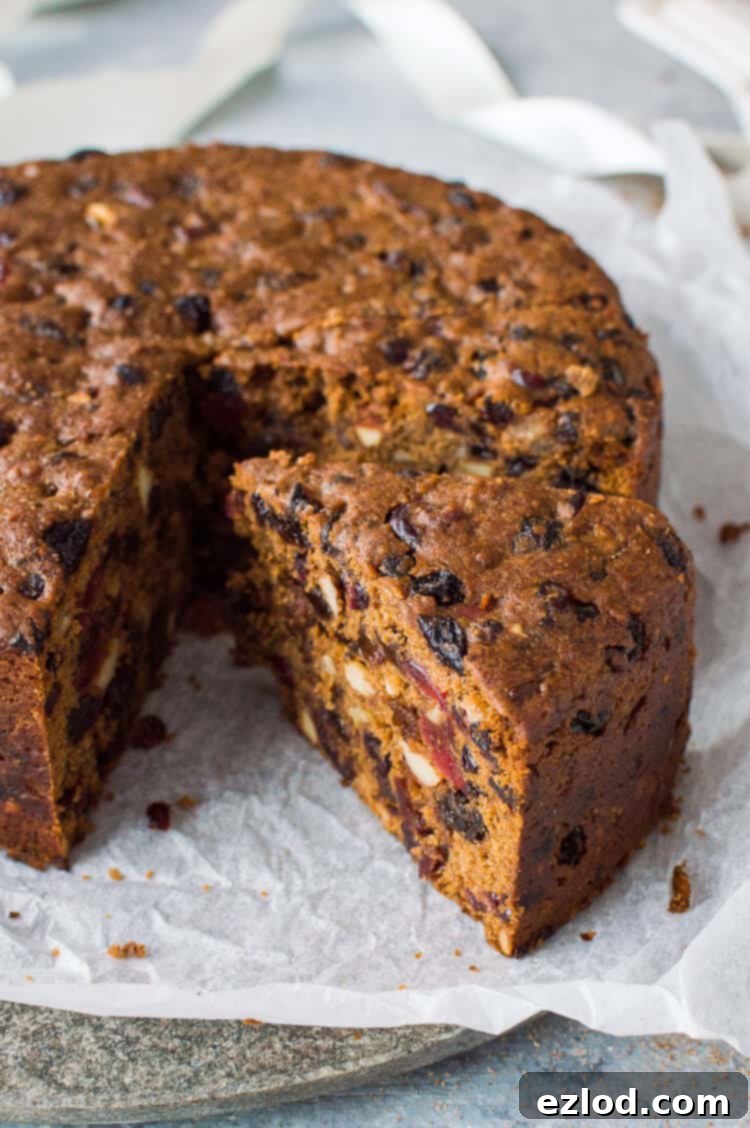
How to Decorate Your Delicious Vegan Christmas Cake
Decorating a Christmas cake is often as much a joyous part of the holiday tradition as baking it. While I chose to keep my cake elegantly plain for the photographs, the possibilities for decoration are truly endless and allow for wonderful creative expression to match your festive theme. Traditionally, Christmas cakes are first adorned with a layer of sweet marzipan, followed by a final, pristine layer of either royal icing or smooth fondant. The excellent news for vegans is that most commercially available marzipan and fondant brands are inherently vegan friendly; however, it’s always a prudent practice to double-check the ingredient list on the packaging to be absolutely sure.
For those who love the crisp, delicate texture of royal icing, you can easily create a superb vegan version by substituting the traditional egg white with aquafaba (the viscous liquid found in a can of chickpeas). Aquafaba whips up beautifully, creating a stable and pipeable icing that works just as well. Before applying the marzipan, a thin brush of warm apricot jam on the cake surface creates the perfect adhesive, ensuring your marzipan layer adheres securely and smoothly in place.
Once your cake is expertly iced and set, let your imagination run wild with embellishments. I adore a simple yet striking approach, piling varying sizes of homemade gingerbread star biscuits on top for a rustic, charming, and undeniably festive look. For visual inspiration and a detailed recipe, you can refer to my gingerbread topped Christmas cake recipe. To make a vegan version of the gingerbread, simply swap the butter for dairy-free margarine or coconut oil, ensuring the same delicious results. You can then use the vegan royal icing recipe from my Tombstone cupcakes to beautifully ice the gingerbread biscuits, adding intricate details or simple outlines before arranging them on your magnificent cake. Other decoration ideas include candied fruits, edible glitter, or fresh cranberries and rosemary for a more natural, minimalist look.
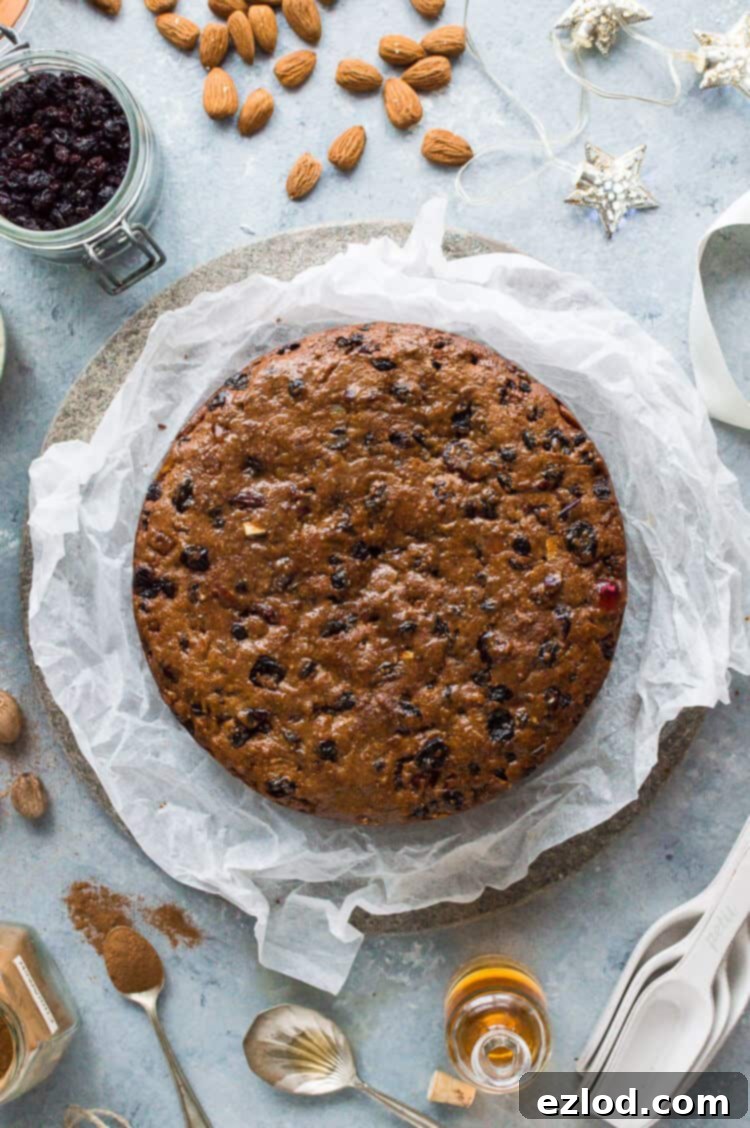
Step-by-Step Guide: How To Make This Incredible Vegan Christmas Cake
(For precise ingredient quantities and full, detailed instructions, please refer to the comprehensive recipe card below. This section provides an expanded, step-by-step walkthrough to guide you through the baking process.)
*For truly stellar and consistent results, meticulous adherence to the recipe, particularly with measurements, is absolutely key. I strongly advocate for using gram measurements with a digital scale over imprecise cup conversions. Cup measurements, by their very nature, lack the accuracy required for successful baking, and I cannot guarantee optimal outcomes if they are used.*
1. Prepare Your Boozy Dried Fruit (The Day Before)
This is where the magic of flavour infusion begins! At least one full day before you plan to bake, combine all your chosen dried fruits – the mix of raisins, sultanas, currants, cranberries, mixed candied peel, and carefully halved glace cherries – in a large, clean bowl that comes with a lid. Generously pour over the rum or brandy, ensuring all the fruit is thoroughly coated. Stir everything together well, then securely cover the bowl with its lid and allow the fruits to soak. This soaking period is critically vital for two main reasons: it plumps the fruit, transforming it into juicy pockets of flavour, and it infuses it with a deep, rich boozy essence. While an overnight soak is the minimum, leaving them to luxuriate for up to a week, with an occasional stir to redistribute the liquid, will yield an even more magnificent and flavourful cake, intensifying the festive notes.
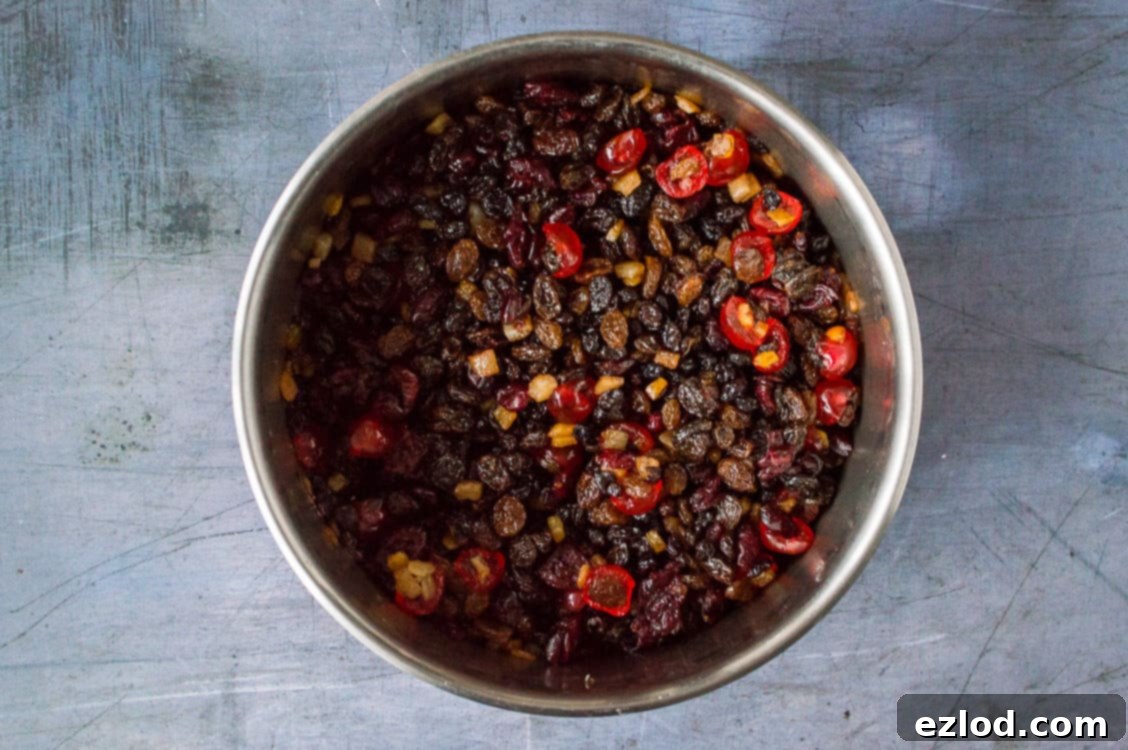
2. Prepare Your Baking Tin with Care
The following day, when you’re ready to bake, begin by preheating your oven to a gentle 140°C/120°C fan/275°F/gas mark 1. This consistently low and slow temperature is absolutely crucial for a perfectly baked fruitcake; it prevents the delicate edges from drying out or burning before the dense centre is thoroughly cooked. Next, generously grease a deep 20cm/8-inch round cake tin. Then, line it with a double layer of baking parchment. This extra, thoughtful layer of parchment acts as vital insulation, providing additional protection against the cake burning or becoming too dark around the edges during its extended baking time, ensuring an evenly baked and beautifully coloured crust.
3. Cream the Wet Ingredients for a Fluffy Base
In a large mixing bowl, combine the softened dairy-free margarine (or softened coconut oil, if that’s your chosen fat) with both the dark brown soft sugar and the light brown soft sugar, the sticky treacle, and the finely grated zest of one large orange and one large lemon. Whisk these ingredients together diligently until the mixture becomes wonderfully light and fluffy. This creaming process is essential as it incorporates air, which contributes significantly to the cake’s final texture, and ensures the sugars are thoroughly dissolved, creating a smooth and well-integrated base for your aromatic batter. This step is key to a light yet rich crumb.
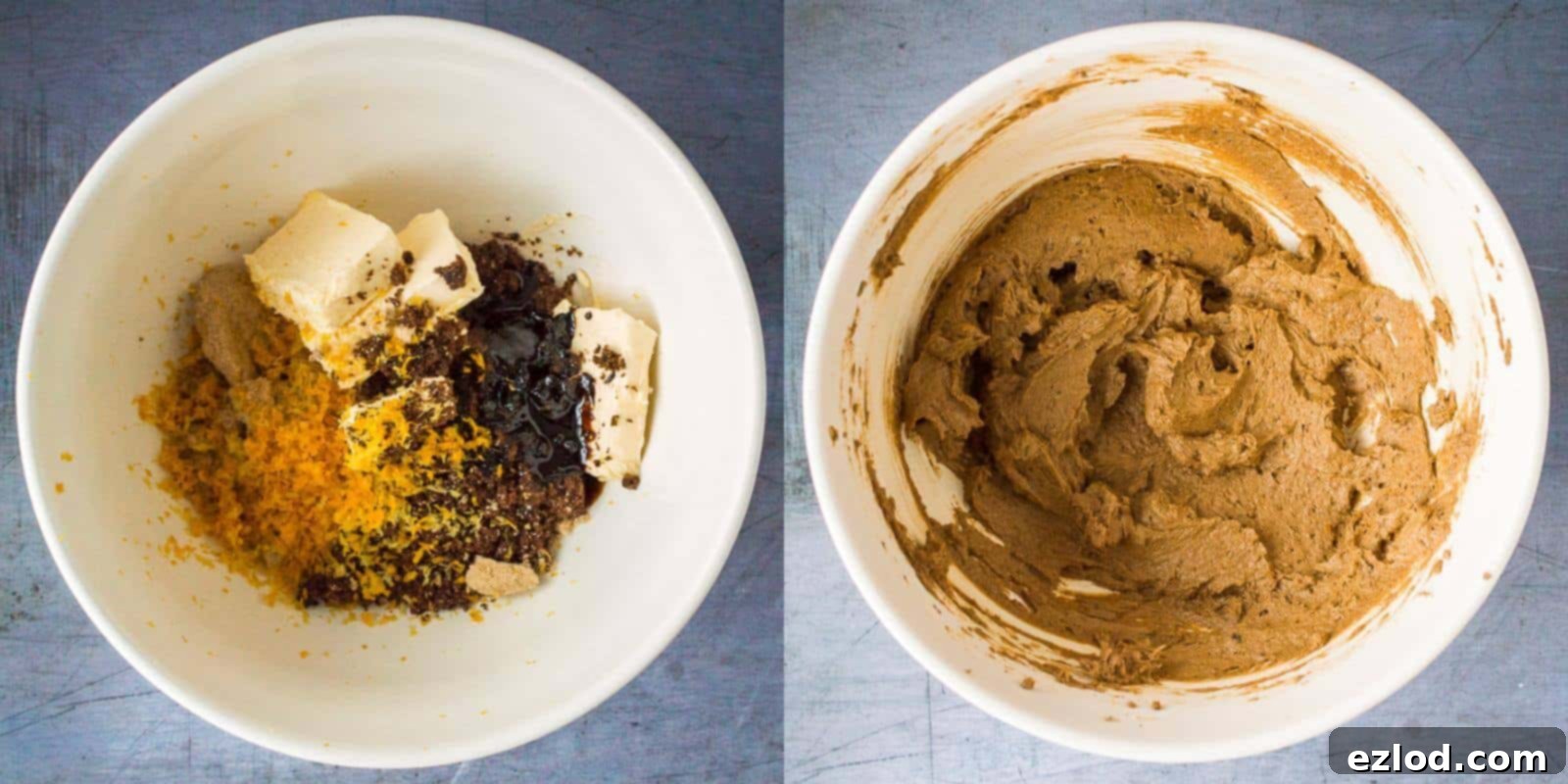
4. Sift and Blend the Dry Ingredients
In a separate, medium-sized bowl, meticulously sift together the plain (all-purpose) flour, finely ground almonds, bicarbonate of soda, mixed spice (or apple pie spice for a similar warm blend), ground cinnamon, and ground nutmeg. Sifting serves multiple purposes: it ensures there are no unwanted lumps in your dry mixture, and more importantly, it helps to evenly distribute the leavening agent and all the fragrant spices throughout the flour, leading to a consistently textured cake with balanced flavour in every bite. This simple step makes a big difference.
5. Thoughtfully Combine Wet and Dry Mixtures
Gently tip the meticulously sifted dry ingredients into the creamed margarine mixture. Simultaneously, add the unsweetened soy milk (or your preferred unsweetened non-dairy milk) and the red wine vinegar. Stir everything together until just combined; it is crucial to be careful not to over-mix, as excessive mixing can overdevelop the gluten in the flour and result in a tough, less tender cake. The batter will be noticeably thick and stiff – this is perfectly normal and indeed desired for a dense, rich fruitcake. If, after combining, the batter appears excessively dry, you may add a tiny splash more milk, but always strive to maintain a stiff consistency to ensure the cake’s characteristic density.
6. Fold in the Star Ingredients: Soaked Fruit and Nuts
Now, it’s time for the true stars of the show! Carefully fold in your previously soaked dried fruits, along with any leftover, delicious liquid that remains from their soaking bowl. Also, add the chopped almonds. Stir gently and thoroughly until all the succulent fruits and crunchy nuts are evenly distributed throughout the thick batter. This careful folding ensures that every single slice of your finished vegan Christmas cake will be packed with a delightful, consistent burst of delicious festive goodness, making each mouthful a truly enjoyable experience.
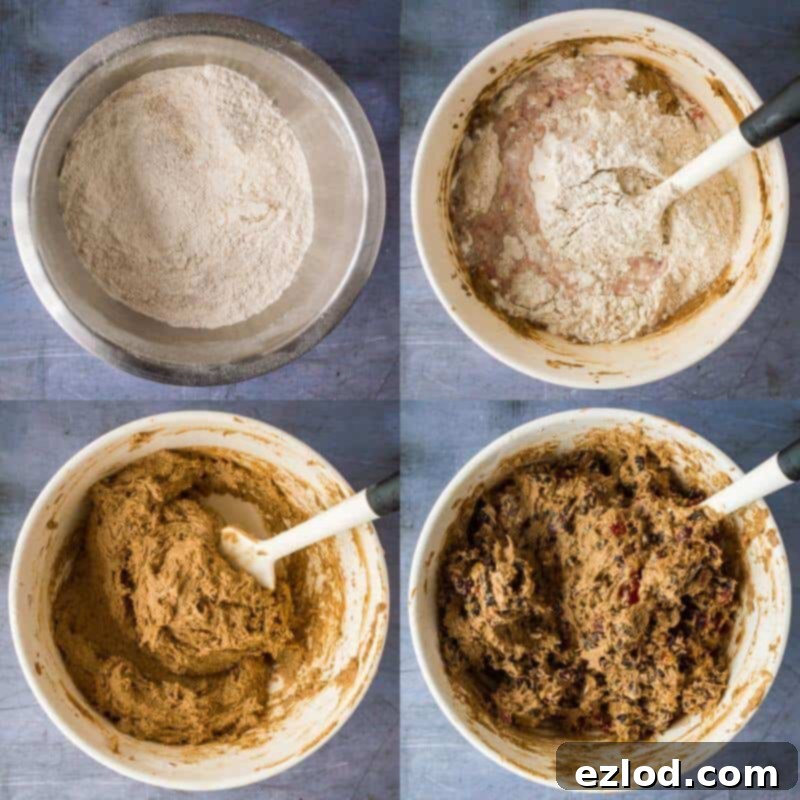
7. Bake to Perfection with Patience
Scrape the thick batter into your meticulously prepared cake tin. Use a spatula to spread it as evenly as possible across the surface. Due to its dense consistency, the batter won’t spread much during baking, so achieving a level surface before it enters the oven is absolutely crucial for ensuring an evenly baked and beautifully presented cake. Bake for approximately 2 to 3 ½ hours. The exact baking time can subtly vary depending on the nuances of your oven, so always rely on the trusty skewer test: a wooden or metal skewer inserted into the very centre of the cake should come out perfectly clean when it’s fully done. My cake typically takes about 2 ½ hours to reach perfection. Once baked, leave the cake to cool completely in the tin on a wire rack. This slow, gradual cooling process helps prevent any shrinking and locks in the precious moisture. Once stone cold, turn it out and generously brush it all over with additional rum or brandy – this is the first crucial “feeding” that kickstarts the flavour maturation!
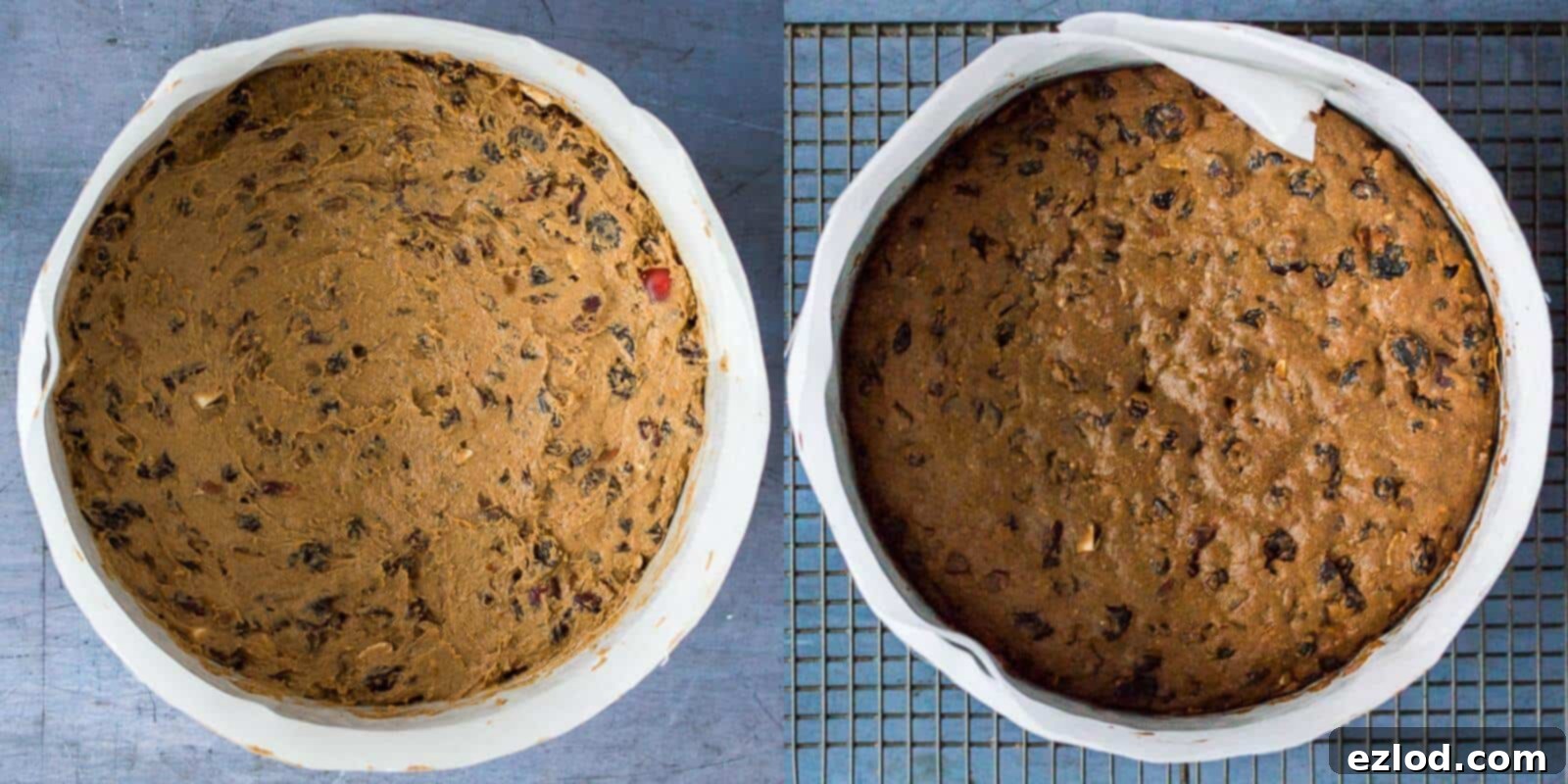
8. Store and “Feed” for Ultimate Maturation
Once the cake is completely cold (this is an absolutely essential step to prevent any unwanted condensation from forming), carefully wrap it tightly first in baking parchment, then securely in tin foil. Store it in an airtight container in a cool, dark place, such as a pantry or a cool cupboard, away from any heat sources. For optimal flavour development and that characteristic rich, mature taste, generously “feed” the cake every week or two with a couple of tablespoons of rum or brandy. To ensure even saturation, alternate applying the spirit to both the top and bottom surfaces of the cake each time. This diligent feeding process can be continued for up to three months, allowing the flavours to deepen and meld beautifully, creating an incredibly rich, complex, and irresistibly boozy festive treat that truly embodies the spirit of Christmas.
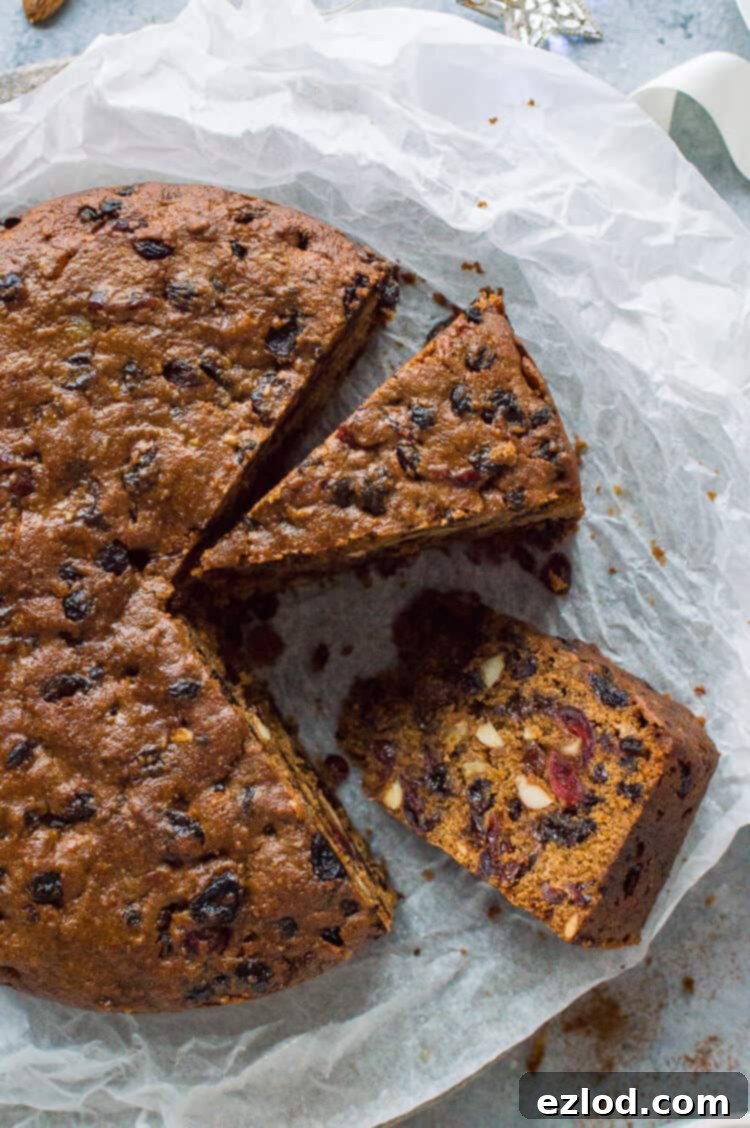
Vegan Christmas Cake Variations and Expert Tips for Success
Customize Your Dried Fruits
The inherent beauty of fruitcake lies in its incredible versatility. While this recipe provides a fantastic, tried-and-tested base, feel free to tailor the dried fruit selection to your personal tastes and preferences. The key is to ensure the total weight of dried fruit remains consistent, around 660g (approximately 23oz), to maintain the cake’s perfect structure and moisture balance. For those who aren’t particularly fond of mixed peel, you can easily substitute it with more of your favourite fruits. Excellent and popular alternatives include finely chopped dried dates, succulent figs, and chewy apricots. For a burst of different colours and varied flavour profiles, consider adding dried cherries, sweet blueberries, or even finely diced pineapple. Each variation will lend a unique and delightful character to your festive bake, making it truly your own.
Alcohol-Free Option for All Ages
If you or your guests prefer an alcohol-free Christmas cake, it’s simple to adapt this recipe. Simply substitute the rum or brandy used for soaking the fruit with the same quantity of robust orange juice or even strong, cooled black tea. These alternatives will still effectively plump the fruit and infuse it with a pleasant flavour, though the depth of flavour will naturally be slightly different from an alcohol-infused cake. It’s important to note that without the natural preserving qualities of alcohol, the shelf life of your cake will be shorter. For an alcohol-free version, it’s best to bake it closer to when you intend to serve it, rather than maturing it for several weeks in advance. Enjoy this delightful cake with everyone!
Additional Expert Tips for Your Baking Success:
- Don’t Rush the Fruit Soak: As highlighted, the longer the fruit soaks, the better the flavour development and the more succulent the texture of your finished cake. This patience truly pays off in the final taste.
- Gram Measurements are King: For consistent, reliable, and professional baking results, always use a digital scale for gram measurements. Cup conversions, by their very nature, can be imprecise and often lead to varying and inconsistent outcomes.
- Gentle Mixing is Key: Be mindful not to over-mix the batter. Excessive mixing can overdevelop the gluten in the flour, resulting in a cake with a tough, less tender crumb. Mix only until just combined.
- Cool Completely: Before wrapping and storing your cake, it is absolutely essential to ensure it is stone cold. Wrapping a warm cake will create unwanted condensation, which can lead to a soggy cake or, worse, mould growth.
- Regular Feeding for Maturation: If you’re maturing your cake for weeks, do not forget the weekly or bi-weekly feeding! This step is crucial for keeping it incredibly moist and intensifying that rich, boozy flavour over time.
- Storage Matters: Always store your vegan Christmas cake in a cool, dark place in an airtight container to keep it fresh and flavourful for longer.
More Festive Vegan Recipes to Explore:
Looking for even more delicious and inspiring vegan treats to brighten your holiday season? Explore these other delightful recipes from our collection:
- Easy Vegan Ginger Sheet Cake
- Indulgent Vegan Steamed Chocolate Pudding
- Classic Vegan Mince Pies
- Festive Mulled Wine Brownies (Vegan)
- Charming Woodland Animal Ginger Cake (Vegan)
- Decadent Chocolate, Orange and Almond Cake (Vegan)
- Beautiful Starry Mince Pie Tart (Vegan)
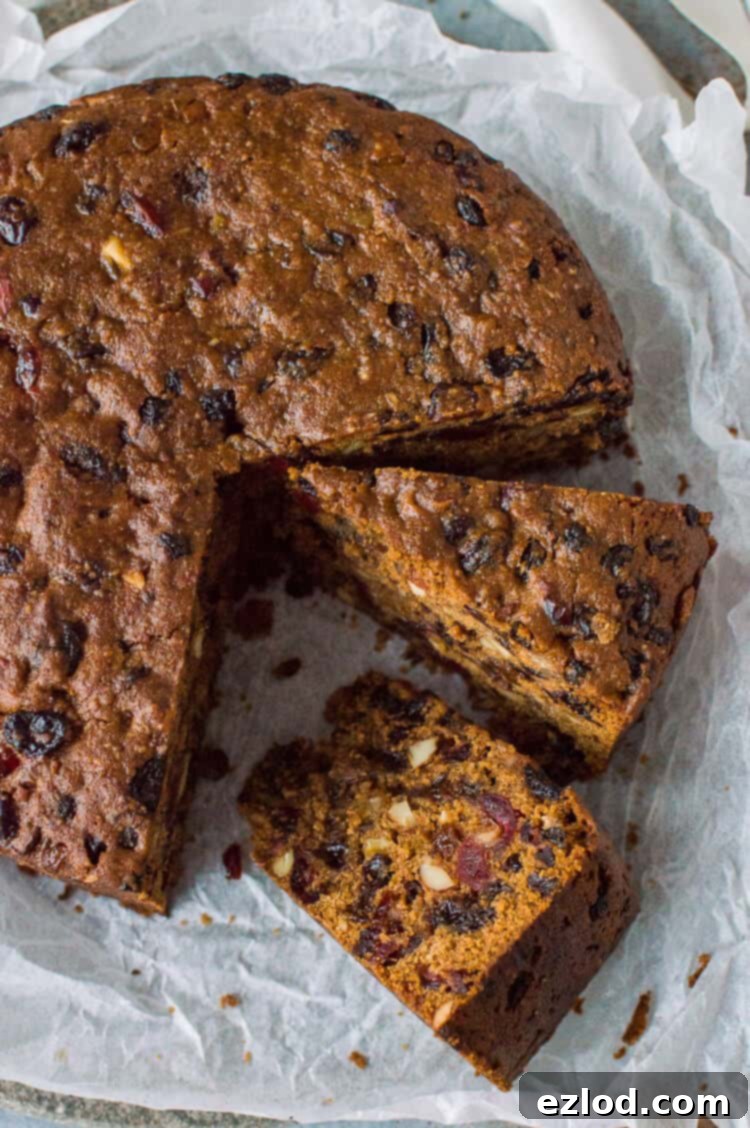
If you tried this incredible vegan Christmas cake recipe, we’d absolutely love to see your festive creations! Don’t forget to tag @domestic_gothess on Instagram and use the hashtag #domesticgothess. Your delicious bakes inspire us and our community!
*All images and content on Domestic Gothess are copyright protected. If you wish to share this recipe, please do so by exclusively using the provided share buttons. Reproduction of the recipe or content in full, including screenshots, is strictly not permitted without prior written consent.*

Print
Vegan Christmas Cake
Ingredients
- 125 g (4.5oz) raisins
- 125 g (4.5oz) sultanas
- 125 g (4.5oz) currants
- 100 g (3.5oz) dried cranberries
- 100 g (3.5oz) mixed candied peel
- 85 g (3oz) glace cherries halved
- 100 ml (⅓ cup + 1Tbsp + 1tsp) rum or brandy
- 175 g (⅔ cup + 1Tbsp) vegan block butter/margarine (I use Naturli Vegan Block) softened
- 125 g (⅔ cup) dark brown soft sugar
- 50 g (⅓ cup) light brown soft sugar (or more dark brown sugar)
- 30 g (one rounded Tbsp) treacle (or molasses)
- finely grated zest of 1 large orange
- finely grated zest of 1 large lemon
- 350 g (3 cups minus 2 Tbsp) plain (all-purpose) flour
- 40 g (⅓ cup) ground almonds
- ¾ tsp bicarbonate of soda
- 1 tsp mixed spice (apple pie spice)
- ½ tsp ground cinnamon
- ½ tsp ground nutmeg
- 120 ml (½ cup) unsweetened soy milk (or other unsweetened non-dairy milk)
- 2 Tbsp lemon juice or red or white wine vinegar
- 60 g (2oz) almonds chopped
- rum or brandy for feeding
Instructions
-
Start preparing the fruit at least the day before you want to bake the cake.
Mix all of the dried fruits together in a large bowl that has a lid, add the rum, stir well, then cover and leave overnight (or for up to a week – give it an occasional stir).
-
The following day, preheat the oven to 140°C/120°C fan/275°F/gas mark 1. Grease a deep 20cm/8inch round cake tin and line it with a double layer of baking parchment.
-
In a large bowl, whisk together the dairy free margarine (or softened coconut oil), dark and light brown sugars, treacle and orange and lemon zest until fluffy.
-
In a separate bowl, sift together the plain flour, ground almonds, bicarbonate of soda, mixed spice, cinnamon and nutmeg.
-
Tip the dry ingredients into the margarine mix, along with the soy milk and red wine vinegar. Stir until just combined; be careful not to over-mix. The batter should be very thick. If it is really dry you can add a drop more milk but be careful not to add too much, the batter should be stiff.
-
Stir in the soaked dried fruits, along with any leftover liquid, and the chopped almonds.
-
Scrape the batter into the prepared tin and use a spatula to spread it level. Because it is so thick it doesn’t spread much in the oven so it is important that you get it as even as you can.
-
Bake for 2-3 ½ hours until a skewer inserted into the centre comes out clean; mine took 2 ½ hours. Leave the cake to cool completely in the tin on a wire rack then turn it out and brush all over with rum or brandy.
-
Wrap the cake up in baking parchment then tin foil (it MUST be completely cold first), and store in an airtight container, feeding every week or two with rum or brandy, for up to three months.
Video
Notes
- For the best results make sure that you follow the recipe closely. As always, I highly recommend using the gram measurements (with a digital scale), rather than the cup conversions. Cup measurements are simply not accurate enough for baking and I cannot guarantee the best results if you use them.
- This cake cannot be made gluten-free. It will likely be very crumbly. I have a separate gluten-free vegan Christmas cake recipe.
- The dried fruit needs to be soaked at least overnight so do make sure that you start this cake the day before you want to bake it. The fruit can be left to soak for up to a week – I gave mine three days.
- You can vary the types of dried fruit that you add to suit your own tastes (I know quite a few mixed peel haters!), as long as you keep the same overall weight – a total of 660g. Chopped dried dates, figs and apricots all work well, and you could even add dried cherries, blueberries or pineapple.
- I have successfully stored this cake for three months, feeding it with a little rum every week or two. It is a little more delicate than non-vegan fruitcake so be very gentle with it and store it in a tin so as not to squash it.
- I adapted this recipe by The Hungry Veggie to make this cake, with tweaks to suit my tastes: http://thehungryvegan.blogspot.com/2011/12/vegan-christmas-cake.html
